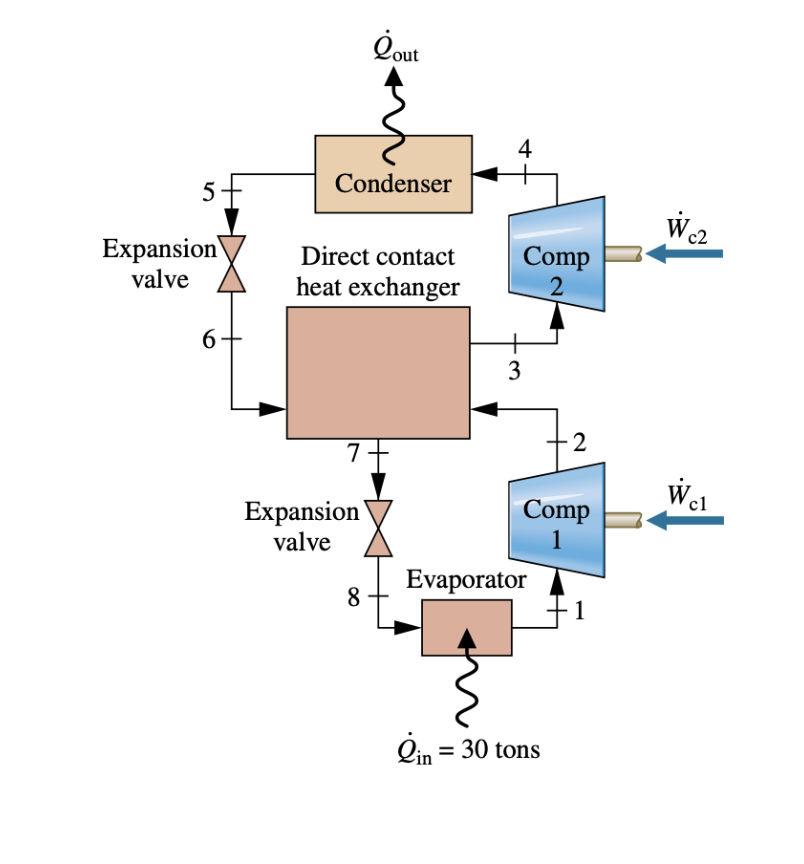Figure below shows a two-stage vapor-compression refrigeration system with ammonia as the working fluid. The system uses a direct-contact heat exchanger to achieve intercooling. The evaporator has a refrigerating capacity of 30 tons and produces −20°F saturated vapor at its exit. In the first compressor stage, the refrigerant is compressed adiabatically to 80 lbf/ in 2 , which is the pressure in the direct contact heat exchanger. Saturated vapor at 80 lbf/ in 2 enters the second compressor stage and is compressed adiabatically to 250 lbf/ in 2 . Each compressor stage has an isentropic efficiency of 85%. There are no significant pressure drops as the refrigerant passes through the heat exchangers. Saturated liquid enters each expansion valve. Determine a) the ratio of mass flow rates, ?̇ 3 /?̇ 1 b) the power input to each compressor stage, in horsepower. c) the coefficient of performance.
Figure below shows a two-stage vapor-compression refrigeration system with ammonia as the working fluid. The system uses a direct-contact heat exchanger to achieve intercooling. The evaporator has a refrigerating capacity of 30 tons and produces −20°F saturated vapor at its exit. In the first compressor stage, the refrigerant is compressed adiabatically to 80 lbf/ in 2 , which is the pressure in the direct contact heat exchanger. Saturated vapor at 80 lbf/ in 2 enters the second compressor stage and is compressed adiabatically to 250 lbf/ in 2 . Each compressor stage has an isentropic efficiency of 85%. There are no significant pressure drops as the refrigerant passes through the heat exchangers. Saturated liquid enters each expansion valve. Determine a) the ratio of mass flow rates, ?̇ 3 /?̇ 1 b) the power input to each compressor stage, in horsepower. c) the coefficient of performance.
Principles of Heat Transfer (Activate Learning with these NEW titles from Engineering!)
8th Edition
ISBN:9781305387102
Author:Kreith, Frank; Manglik, Raj M.
Publisher:Kreith, Frank; Manglik, Raj M.
Chapter7: Forced Convection Inside Tubes And Ducts
Section: Chapter Questions
Problem 7.14P
Related questions
Question
Figure below shows a two-stage vapor-compression refrigeration system with ammonia
as the working fluid. The system uses a direct-contact heat exchanger to achieve intercooling. The
evaporator has a refrigerating capacity of 30 tons and produces −20°F saturated vapor at its exit.
In the first compressor stage, the refrigerant is compressed adiabatically to 80 lbf/ in 2 , which is the
pressure in the direct contact heat exchanger. Saturated vapor at 80 lbf/ in 2 enters the second
compressor stage and is compressed adiabatically to 250 lbf/ in 2 . Each compressor stage has an
isentropic efficiency of 85%. There are no significant pressure drops as the refrigerant passes
through the heat exchangers. Saturated liquid enters each expansion valve. Determine
a) the ratio of mass flow rates, ?̇ 3 /?̇ 1
b) the power input to each compressor stage, in horsepower.
c) the coefficient of performance.
as the working fluid. The system uses a direct-contact heat exchanger to achieve intercooling. The
evaporator has a refrigerating capacity of 30 tons and produces −20°F saturated vapor at its exit.
In the first compressor stage, the refrigerant is compressed adiabatically to 80 lbf/ in 2 , which is the
pressure in the direct contact heat exchanger. Saturated vapor at 80 lbf/ in 2 enters the second
compressor stage and is compressed adiabatically to 250 lbf/ in 2 . Each compressor stage has an
isentropic efficiency of 85%. There are no significant pressure drops as the refrigerant passes
through the heat exchangers. Saturated liquid enters each expansion valve. Determine
a) the ratio of mass flow rates, ?̇ 3 /?̇ 1
b) the power input to each compressor stage, in horsepower.
c) the coefficient of performance.

Transcribed Image Text:5
Expansion
valve
6
Lout
Condenser
Expansion
valve
an
Direct contact
heat exchanger
8
4
Comp
2
3
Comp
Evaporator
2
in = 30 tons
Wc2
Wc1
Expert Solution
This question has been solved!
Explore an expertly crafted, step-by-step solution for a thorough understanding of key concepts.
Step by step
Solved in 3 steps with 1 images

Knowledge Booster
Learn more about
Need a deep-dive on the concept behind this application? Look no further. Learn more about this topic, mechanical-engineering and related others by exploring similar questions and additional content below.Recommended textbooks for you

Principles of Heat Transfer (Activate Learning wi…
Mechanical Engineering
ISBN:
9781305387102
Author:
Kreith, Frank; Manglik, Raj M.
Publisher:
Cengage Learning

Refrigeration and Air Conditioning Technology (Mi…
Mechanical Engineering
ISBN:
9781305578296
Author:
John Tomczyk, Eugene Silberstein, Bill Whitman, Bill Johnson
Publisher:
Cengage Learning

Principles of Heat Transfer (Activate Learning wi…
Mechanical Engineering
ISBN:
9781305387102
Author:
Kreith, Frank; Manglik, Raj M.
Publisher:
Cengage Learning

Refrigeration and Air Conditioning Technology (Mi…
Mechanical Engineering
ISBN:
9781305578296
Author:
John Tomczyk, Eugene Silberstein, Bill Whitman, Bill Johnson
Publisher:
Cengage Learning